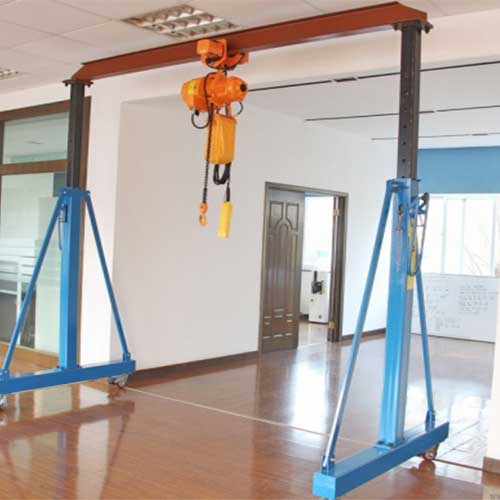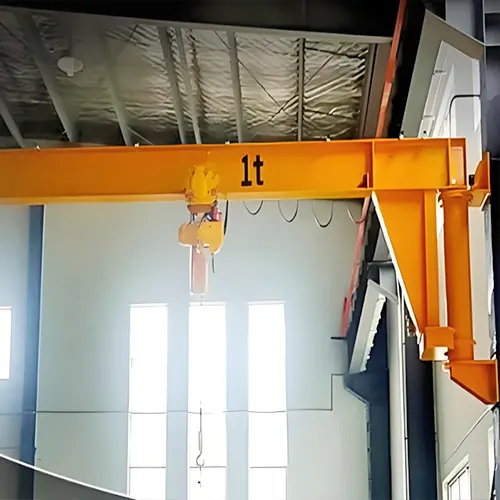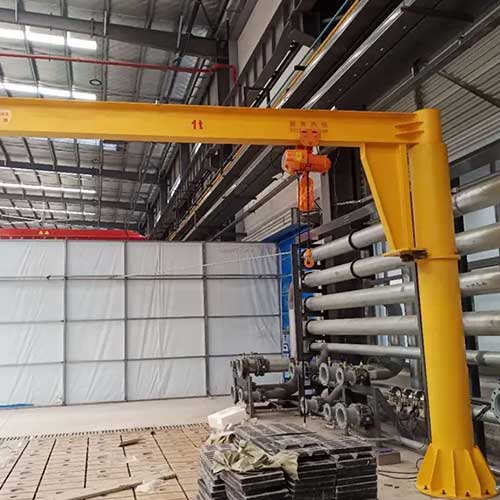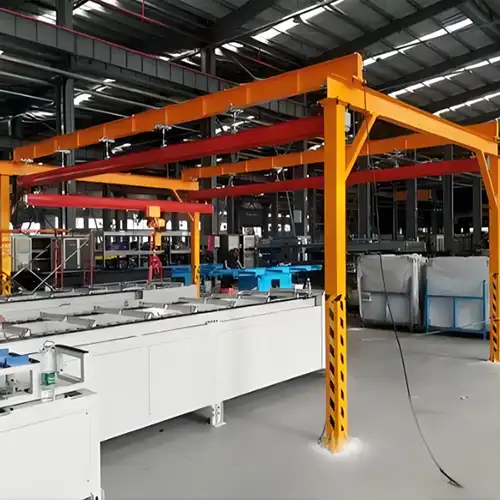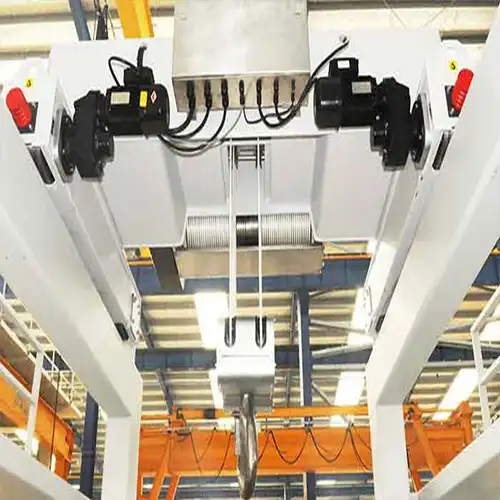1 Ton Overhead Crane Price: Best Options for Light Lifting
Explore cost-effective 1-ton overhead crane solutions ideal for light lifting, compact workshops, and basic industrial material handling needs.
Category: Ton & Price
Your Trusted Overhead Crane Manufacturer & Supplier
1 Ton Overhead Crane for Sale, Economical Crane Solutions
1 Ton Overhead Crane Price: Best Options for Light Lifting
Explore your best options and pricing insights for 1 ton overhead cranes. Ideal for compact workshops, cleanrooms, and light-duty lifting tasks, these cranes offer cost-effective and flexible solutions for small operations.
Introduction
A 1 ton overhead crane is a practical, everyday tool for businesses that need to lift small loads safely and with less hassle. It's not oversized, not overbuilt, and doesn't need a huge installation budget. That's exactly why it works so well in places like compact workshops, maintenance bays, clean production areas, and even small fabrication shops.
It's not just about picking a crane—it's about picking one that fits your space, workload, and setup. And the price? That's what makes many buyers pause and compare. The 1 ton overhead crane price varies quite a bit depending on design, lifting height, span, and how it will be used.
Why buyers choose a 1 ton crane:
- Fits into tight spaces – You don't need a big ceiling or wide runway.
- Light-duty jobs only – It's perfect for occasional lifts or tools, motors, and parts under 1 ton.
- Cost-effective – In many cases, you can get started with a low upfront cost and still have solid lifting performance.
Where they're commonly used:
- Cleanrooms and food processing areas – with stainless steel options to prevent corrosion.
- Small workshops or garages – where space is limited but lifting is still needed regularly.
- Maintenance departments – for lifting pumps, motors, valves, or machine parts during servicing.
There's no need to overcomplicate things. A 1 ton crane gives you just enough lifting power without the burden of a heavy structural setup. But before you buy, it's worth understanding what affects the price—and how to choose a design that fits your needs without going over budget.
1 Ton Overhead Crane Types, Specifications & Price Table
Not all 1-ton lifting systems are the same. Depending on your workspace, installation conditions, and lifting routine, the right type of crane can look very different—from a small movable gantry to a full double girder system. Some buyers want something simple and mobile. Others need a permanent installation for regular lifting in a specific spot.
Below is a practical breakdown of different types of cranes that support up to 1 ton of lifting capacity. It includes span range, lifting height, power supply, use cases, and a general pricing range to help you quickly compare and shortlist options that might suit your facility. Check to learn more on 1 ton overhead crane options.
Comparison Table – 1 Ton Ovehead Crane Options
| Crane Type | Span (m) | Lifting Height (m) | Power Supply (V) | Features / Use Case | Price (USD) |
|---|---|---|---|---|---|
| Single Girder Overhead Crane 1 Ton | 7.5 – 31.5 | 6 – 30 | 220–480 / 3 / 50 | A standard top-running design. Good for light-to-medium duty cycles in workshops. | $2,200 – $40,000 |
| Double Girder Overhead Crane 1 Ton | 7.5 – 31.5 | 6 – 30 | 220–480 / 3 / 50 | Heavier frame, more hook lift height, longer use cycles. More structure, more cost. | $4,000 – $60,000 |
| Single Girder Gantry Crane 1 Ton | 7.5 – 31.5 | 6 – 30 | 220–480 / 3 / 50 | Often used outdoors or in open yards. Good choice when building structure isn't available. | $2,200 – $40,000 |
| Double Girder Gantry Crane 1 Ton | 7.5 – 31.5 | 6 – 30 | 220–480 / 3 / 50 | Stronger and larger than the single girder. Handles bigger outdoor spans and longer working hours. | $4,000 – $60,000 |
| Portable Gantry Crane 1 Ton | 2 – 12 | 1 – 9 | 220–480 / 3 / 50 | Flexible and mobile. Ideal for temporary use or multi-location lifting in small shops. | $1,500 – $15,000 |
| Pillar Jib Crane 1 Ton | 3 – 12 | 3 – 8 | 220–480 / 3 / 50 | Bolts to the floor. Rotates around a post—great for workstations or lifting in tight corners. | $2,000 – $7,000 |
| Wall Mounted Jib Crane 1 Ton | 3 – 8 | 6 – 30 | 220–480 / 3 / 50 | Fixed to a wall or column. No floor space needed. Swing arm reaches over machines or benches. | $2,500 – $8,000 |
| Wall Travelling Jib Crane 1 Ton | 5 – 12.5 | 6 – 30 | 220–480 / 3 / 50 | Moves along a wall-mounted track. Great for long, narrow workspaces like assembly lines. | $4,100 – $21,000 |
| Electric Hoist (Standalone) 1 Ton | – | – | 220–480 / 3 / 50 | A standalone hoist that can be mounted on beams, frames, or even custom trolleys. | $500 – $3,000 |
Common Applications for 1 Ton Overhead Cranes
A 1 ton overhead crane isn't built for lifting steel coils or massive machinery—but that's exactly why it shines in smaller, more focused environments. It fills the gap where lifting needs are real, but the workload doesn't justify heavy-duty equipment. These cranes are commonly found in places where efficiency, space, and safety all matter—especially when you're working with tight layouts or lighter materials.
Let's break down where they're used and why they're a good fit.
Compact Industrial or Mechanical Workshops
These are often small operations where floor space is limited, and workers are already navigating around machines and benches. A 1 ton overhead crane is ideal here because:
- It can be mounted overhead or on the wall, keeping the floor free for other work.
- It helps reduce manual lifting, especially for small molds, tools, or motor components.
- Setup can be straightforward—many small shops opt for crane kits or freestanding systems to avoid modifying the building.
Small-Scale Manufacturing or Assembly Lines
These operations deal with repeated lifting of small parts or assemblies. A 1 ton overhead crane brings consistency and reduces worker fatigue.
- Can be positioned above the line to reduce unnecessary walking or pushing of carts.
- Hoists can be electric or manual, depending on how often lifting is required.
- Suitable for stations where components are regularly moved between jigs, welding stations, or inspection areas.
Automotive Maintenance Bays
This is a big one. Auto service shops and garages often need to lift engines, transmissions, or other vehicle parts. Many use mobile or wall-mounted options that are easy to integrate into service areas.
- A portable gantry crane with wheels can move between bays.
- Helps remove and install components safely, especially when space for an engine hoist or forklift is limited.
- Less expensive than full shop cranes, and more precise than floor jacks for lifting.
Research Facilities and Cleanrooms
In clean environments where contamination or dust control is important, lifting equipment must meet stricter standards. A light crane helps avoid manual handling without interfering with sensitive setups.
- Stainless steel or aluminum construction options are available for hygienic compliance.
- Smooth, controlled lifting prevents vibration or product disruption.
- Overhead or wall-mounted designs maintain clean floor access and allow easy movement of light testing devices or instruments.
Warehousing or Material Sorting Stations
These cranes help workers lift boxes, pallets, dies, or small tools in and out of storage. Especially in confined areas or mezzanines, an overhead or jib crane is the right fit.
- Can be mounted to mezzanine structures or walls.
- Reduces manual handling injuries.
- Good for lifting materials from one level to another in multi-floor storage systems.
A Few Practical Notes for Buyers:
Price Variation Depends on Custom Specs:
The listed price ranges are general references. Actual costs vary with your requested lifting height, span, power system, and optional features like VFDs (variable frequency drives), wireless remotes, or explosion-proof hoists.
Outdoor or Harsh Environments Add Cost:
If your crane will operate outdoors or in dusty, humid, or chemical-heavy environments, it's smart to ask for:
- Stainless steel components
- IP55/IP65-rated enclosures
- Rain covers or corrosion-resistant painting
- Weatherproof electric controls
Fixed vs. Mobile Design Options:
- Gantry cranes and jib cranes come in both fixed and adjustable versions. Portable gantries often include lockable caster wheels, while some jib cranes have manual slewing limits to match confined space layouts.
- Mobile cranes are usually more affordable upfront and require no permanent installation, but may offer less hook height or span than built-in options.
This table gives you a practical starting point. Whether you're lifting parts in a maintenance shop or transporting small loads outdoors, choosing the right type of 1-ton crane saves both time and long-term cost. If your team can fabricate structural parts locally, buying a crane kit (without the girder) is another way to reduce expenses and shorten delivery time.
Key Questions and Concerns from 1 Ton Overhead Crane Buyers
Buying a 1 ton overhead crane might seem straightforward, but it's normal to have plenty of questions. After all, it's an important piece of equipment that needs to fit your space, your workflow, and your budget without surprises. Here are some of the most common concerns buyers raise—and practical answers to help you decide.
1. How much space is needed for installation?
Space is often the biggest challenge in smaller workshops or cleanrooms. Even though 1 ton cranes are compact, you still need to consider:
- Hook approach: How far the crane's hook can move close to walls or obstacles.
- Headroom: The distance from the floor to the lowest part of the crane or hoist. Low ceilings can limit your options.
- Runway length: The length of the track or beam the crane travels on.
Take measurements of your workspace before choosing. Some cranes require just a few centimeters of clearance, but it varies widely by type and design.
2. Can it be installed without major modifications?
Many buyers want a crane that fits into their existing setup with minimal construction. Good news:
- Wall-mounted jib cranes often require just a strong mounting point on a wall or column—no floor space needed.
- Portable gantry cranes don't require any building changes at all—they simply roll where you need them.
- Single girder overhead cranes usually need runway beams installed, which might require structural reinforcement depending on your building.
If avoiding costly building work is a priority, portable or jib cranes are usually the easiest to fit.
3. How do I know which type is right for my needs?
Picking the right crane type depends on a few key factors:
- Is the lifting area fixed or does the load move around?
Fixed stations can use jib or overhead cranes. If you need to lift in multiple places, gantry or portable cranes might work better. - Do you need the crane to move with the load?
Portable gantry cranes offer mobility. Overhead cranes are fixed but provide smooth and precise movement along beams. - What's the ceiling clearance?
Low ceilings often rule out traditional top-running cranes. Underslung or jib cranes are better for tight vertical spaces. - Where can the crane be mounted?
Wall or column mounting points limit you to jib cranes. If no mounting is possible, gantry cranes or portable systems are better options.
4. Will the crane be compatible with our existing power supply?
Most industrial cranes use three-phase power, commonly in the range of 220 to 480 volts and either 50 or 60 Hz frequency. However:
- Confirm your facility's power specs before ordering.
- Some manufacturers can customize voltage or frequency settings but expect this to increase cost and lead time.
- For facilities without three-phase power, manual or air-powered hoists might be alternatives.
5. What safety features come standard?
Safety should never be overlooked. Typical safety features on 1 ton cranes include:
- Limit switches: Prevent the hoist from lifting beyond safe height or traveling off the runway.
- Overload protection: Stops lifting if the load exceeds rated capacity, protecting equipment and personnel.
- Emergency stop buttons: Allow quick shutdown in case of unexpected issues.
- Optional upgrades: Wireless remote controls for safer operation, or inverter drives (VFDs) for smooth starts and stops.
Make sure your supplier includes these or offers them as options.
6. How can I reduce costs without sacrificing safety or quality?
Balancing cost and quality is a top concern. Here are some practical tips:
- Consider modular crane kits if you have access to local fabrication or assembly expertise. This can lower manufacturing and shipping costs.
- Stick to standard spans and lifting heights where possible. Custom dimensions add to the price.
- Avoid unnecessary extras. Add only the controls or features you really need.
- For occasional use, manual chain hoists can save money compared to fully electric hoists.
- Plan ahead for maintenance. Buying quality now saves costly downtime later.
How to Choose the Right 1 Ton Overhead Crane for Your Facility
Picking the right 1 ton overhead crane isn't just about the price tag—it's about making sure the crane fits your facility's specific needs. Getting this right upfront can save you headaches, extra costs, and downtime down the road. Here are some key factors to consider as you make your decision.
Installation Space
One of the first things to look at is how much space you have to work with. Low ceilings and cramped workshops often limit your options.
- Underslung cranes are designed to hang below existing beams, making the most of limited headroom.
- Wall-mounted jib cranes don't take up any floor space and work well when you have sturdy walls or columns.
- Avoid cranes that require heavy structural changes unless you're planning a big facility upgrade.
Measuring your space carefully—including ceiling height, runway length, and approach distances—is essential before ordering.
Load Frequency and Duty Cycle
How often you plan to use the crane affects the type of hoist and overall crane design you should choose.
- If lifting happens several times a day, invest in a crane designed for heavier duty cycles with a reliable electric hoist. These cranes are built to handle continuous or repetitive loads without overheating or wearing out quickly.
- For occasional or light use, a manual chain hoist might be enough, saving on upfront and maintenance costs. These are simple and easy to operate but not suited for heavy workloads.
Think about your workflow and how critical the crane's availability is.
Control Method
How the crane is controlled affects both safety and operator comfort.
- Pendant controls are common and straightforward. Operators control the crane from a stationary spot using a wired pendant.
- Wireless remote controls add flexibility by allowing operators to move freely while controlling the crane, improving visibility and safety.
- Push-pull trolleys require manual movement of the hoist along the beam, suitable for simple, low-frequency jobs.
Choose the control style that fits your operators' needs and safety standards.
Application Environment
The conditions where the crane will operate matter a lot, especially if the environment is harsh or sensitive.
- For humid or corrosive environments, ask about stainless steel hoists or specially coated components that resist rust and corrosion.
- In cleanrooms or food processing, equipment needs to meet hygiene standards and be easy to clean. Stainless or aluminum parts are common here.
- For dusty or outdoor conditions, IP-rated enclosures and weatherproof controls help keep the crane running smoothly.
Knowing your environment helps avoid early failures or compliance issues.
After-Sales Service
Buying the crane is just the beginning. Good after-sales service keeps your crane running and safe for years.
- Look for suppliers who provide full documentation including wiring diagrams, maintenance guides, and certifications like CE or ISO.
- Technical drawings help your local team with installation and future modifications.
- Ask if they offer on-site support or remote troubleshooting, especially if your facility is far from the supplier.
- Consider availability of spare parts and ease of maintenance.
A supplier that stands behind their product makes your investment more secure.
Choosing the right 1 ton overhead crane means balancing space, workload, controls, environment, and support. Taking the time to evaluate these details now helps ensure smooth operations and good value over the long run.
Conclusion
A 1 ton overhead crane is a practical and efficient choice for any business needing light-duty lifting without taking up too much space. Whether you run a small workshop, a cleanroom, or a maintenance bay, these cranes provide just the right amount of lifting power to get the job done safely and smoothly.
Prices for these cranes can vary widely. If you need something simple and mobile, portable gantry cranes can start as low as $1,500. On the other hand, if you require a more robust, permanent setup—like a double girder overhead crane with higher performance and longer duty cycles—the price can reach up to $60,000. This wide range means you can find a solution tailored to your exact needs and budget.
The key to making a smart purchase is to carefully assess your:
- Available workspace and installation limitations
- Existing or planned power supply
- Desired control system and operator convenience
- Expected frequency and type of lifting tasks
By matching these factors to the right crane type and features, you avoid overspending on unnecessary capacity or ending up with a crane that can't handle your workload. Safety and performance should never be compromised, and with the right choice, you get both at a reasonable cost.
If you're unsure about which 1 ton overhead crane is best for your facility, or want to make sure you're getting the best price and specifications, don't hesitate to reach out.
We specialize in helping businesses like yours find the perfect lifting solution. From comparing crane types to customizing specifications that fit your exact environment and lifting needs, we're here to guide you every step of the way.
Contact us today for a personalized 1 ton overhead crane price quote and expert technical consultation. We offer:
- CE-certified, high-quality cranes
- Global shipping and delivery options
- Tailored support and after-sales service
Let us help you get the right crane that works reliably and fits your budget. Your safe and efficient lifting solution is just a message away.
Related Products
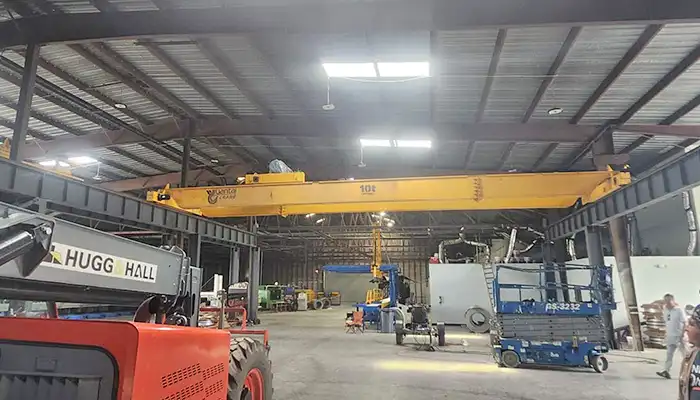
Affordable 10 ton double girder overhead crane with CD/MD hoist trolley, built for U.S. standards, ideal for construction and industrial lifting
Free consultation to Confirm Parameters & Specifications and Get
Latest Crane Price & Crane Rate.
- Types of overhead cranes : _______?
- Optional: Overhead travelling crane, goliath gantry crane,Slewing jib crane, Single girder or double girder crane,small portable crane or kbk crane, etc.
- Capacity of overhead crane: _______?
- Optional: 0.25ton, 0.5 ton, 1 ton, 2 ton, 3ton, 5 ton, 10 ton,15ton, 20ton, 25 ton, 30ton,35ton, up to 550ton, etc.
- Crane span & lifting height : _______?
- Crane travelling length : _____?
- Control of overhead crane:_______?
- Optional: pendant/ remote/cabin control
- Voltage supply of overhead crane:_____?
- Eg,: 380V50/60HZ,3Phase or others,etc.
- Application/usage of crane:_______?
- Eg,: Steel mill, ,injection mold, cement,stone, concrete,granite, general manufacturing, etc.
Just leave a message via the contact form and our hoist and crane engineer will contact you with in 24working hours.
Get In Touch


